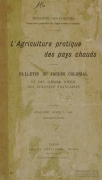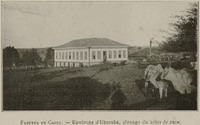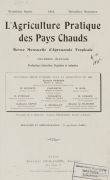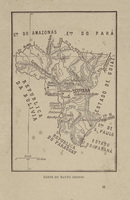Filtrer par
9
résultats
Rappel de recherche : Sujet : Élevage
Modifier les filtres
Exporter les résultats sélectionnés
Sélectionner tous les résultats de la page

-
Notice détaillée
Titre : A preliminary study into the effect of Celmanax on milk composition of Dairy Cows.Intervenant principal : Bridgemohan, PuranEdition : University of the West Indies (Saint-Augustine, Trinidad and Tobago), Université des Antilles. Service commun de la documentation (2015-....), Caribbean Food Crops Society, Institut national de la recherche agronomique (France). Centre de recherches des Antilles et de la GuyaneLieu : Le GosierDate : 12 juillet 2016Extrait de : 52e congrès annuel de la Société caribéenne des plantes alimentaires / 52nd annual meeting of the Caribbean food crops society (CFCS), du 10 au 16 juillet 2016Type : Vidéo - Colloque & conférenceRésumé : The purpose of this study was to investigate the effect on milk composition of the inclusion of a fixed amount of solid prebiotic celmanac into a dairy feed before milking in lactating cows. Fourteen lactating cows, 3-4 mo lactating, were randomly equal in terms of approximate days into lactation, and allocated to one of two treatment groups: Control no Supplementation and Celmanax supplemented. Milk samples were collected every 7 days for approximately 8 weeks and sent to the lab for milk composition analysis and Draminski score testing. Cows supplemented with Celmanax had a higher (p<0.05) butter fat content (2.91%) when compared to the control (2.48%). SNF, protein & lactose percentages were lower (p<0.05) than the control Milk fat, SNF, or lactose percentages were not affected by treatment (P>.01) In conclusion, butterfat percentage was higher for cows supplemented with Celmanax than supplemented cows.Langue : NdjukaMots-clés : Agronomie, agriculture - Environnement - Élevage - Innovation, technologies, industries - 21e siècleConditions d'utilisation : CC-BY-NC-ND - Attribution - Pas d'utilisation commerciale - Pas de modificationProvenance : Université des Antilles


-
Notice détaillée
Titre : Bulletin du jardin colonial et des jardins d'essai des colonies françaises. L'agriculture pratique des pays chauds. 5e année. 2e semestre 1905Extrait de : Bulletin du jardin colonial et des jardins d'essai des colonies françaisesType : Numéro de revueLangue : FrançaisConditions d'utilisation : Domaine publicProvenance : Bibliothèque Alexandre-Franconie


-
Notice détaillée
Titre : Elève du bétail à la GuyaneAuteur : Sagot, Paul Antoine (1821-1888)Edition : Mme Ve C. MellinetLieu : NantesDate : 1870Type : LivreLangue : FrançaisConditions d'utilisation : Domaine publicProvenance : Bibliothèque Alexandre-Franconie


-
Notice détaillée
Titre : Fazenda de Cassu - Environs d'Uberaba, élevage du zébu de raceExtrait de : Au brésil. État de Minas GeraesType : Image - PhotographieConditions d'utilisation : Domaine publicProvenance : Bibliothèque Alexandre-Franconie


-
Notice détaillée
Titre : Longevity, an adaptation trait of creole goats to tropical climateIntervenant principal : Zsuppan, Zsuzsa (19..)Edition : Institut national de la recherche agronomique (France). Centre de recherches, Université des Antilles. Service commun de la documentation (2015-....), Caribbean Food Crops SocietyLieu : Le GosierDate : 12 juillet 2016Extrait de : 52e congrès annuel de la Société caribéenne des plantes alimentaires / 52nd annual meeting of the Caribbean food crops society (CFCS), du 10 au 16 juillet 2016Type : Vidéo - Colloque & conférenceRésumé : The importance of longevity as an economic trait reflects the effectiveness and adaptation of the herd in a particular environment. A study was conducted in the experimental herd of Creole goats at INRA in Guadeloupe to test the environmental factors that affect the longevity of deer. A lifetime dataset of 387 Creole Rabbits, raised on pasture year-round, was recorded over an 11-year period (2001-2012). The deer were bred for reproduction at the age of 11 months. Three mating periods were organized per year, corresponding to 3 climatic seasons, using the male effect. This study gave indications to breeders to improve the management of their female herd and increase the lifespan., L’importance de la longévité en tant que trait économique donne une image de l’efficacité et de l’adaptation du troupeau dans un environnement particulier. Une étude a été menée dans le troupeau expérimental de chèvres créoles à l’INRA en Guadeloupe afin de tester les facteurs environnementaux qui affectent la longévité des biches. Un ensemble de données sur la durée de vie de 387 lapines créoles, élevées au pâturage toute l’année, a été enregistré sur une période de 11 ans (2001-2012). Les biches ont été élevées pour la reproduction à l’âge de 11 mois. Trois périodes d’accouplement ont été organisées par an, correspondant à 3 saisons climatiques, utilisant l’effet mâle. Cette étude a donné des indications aux éleveurs pour améliorer la gestion de leur troupeau de femelles et augmenter la durée de vie.Langue : AnglaisMots-clés : Agronomie, agriculture - Cultures maraîchères - Environnement - Élevage - Innovation, technologies, industries - Guadeloupe - 21e siècleConditions d'utilisation : CC-BY-NC-ND - Attribution - Pas d'utilisation commerciale - Pas de modificationProvenance : Université des Antilles


-
Notice détaillée
Titre : Research framework for the development of Creole pig's niche market in Martinique : a holistic approachIntervenant principal : Gourdine, Jean-Luc (1975-....)Edition : Institut national de la recherche agronomique (France). Centre de recherches, Université des Antilles. Service commun de la documentation (2015-....), Caribbean Food Crops SocietyLieu : Le GosierDate : 12 juillet 2016Extrait de : 52e congrès annuel de la Société caribéenne des plantes alimentaires / 52nd annual meeting of the Caribbean food crops society (CFCS), du 10 au 16 juillet 2016Type : Vidéo - Colloque & conférenceRésumé : The Creole pig has always been part of the rural and suburban landscape of Martinique. Currently, this breed is not included in a research and conservation program. The Natural Park of the Martinique Region (PNRM) aims to maintain and enhance the genetic heritage of the Creole pork of Martinique and develop a niche activity. Based on PNRM knowledge, some Creole pigs live freely in the mountains of the North, on the South coast and with some disparate traditional breeders located in the countryside. It is essential to carry out an inventory of the local pig population to propose a system of conservation and economic development. In order to promote the ownership of the Creole pig niche, the PNRM, as a decision-maker, acts in a systemic and holistic way by considering the entire territory of Martinique and the pig sub-sector: the producers involved in the pig cooperative COOPMAR, researchers from INRA (FWI), the food chain and at least (in a second phase) consumers and Martinique society., Le cochon créole a toujours fait partie du paysage rural et périurbain de la Martinique. Actuellement, cette race n’est pas intégrée dans un programme de recherche et de conservation. Le Parc Naturel de la Région Martinique (PNRM) a pour objectif de maintenir et de valoriser le patrimoine génétique du porc créole de la Martinique et développer une activité de niche. Basé sur les connaissances PNRM, certains cochons créoles vivent librement dans les montagnes du Nord, sur la côte Sud et avec quelques éleveurs traditionnels disparates situés à la campagne. Il est indispensable de réaliser un inventaire de la population porcine locale pour proposer un dispositif de conservation et de développement économique. Afin de favoriser l’appropriation de la niche porcine créole, le PNRM, en tant que décideur, agit de manière systémique et holistique en considérant l’ensemble du territoire martiniquais et le sous-secteur porcin : les producteurs impliqués dans la coopérative porcine COOPMAR, chercheurs de l’INRA (FWI), de la chaîne alimentaire et au moins (dans une seconde phase) les consommateurs et la société martiniquaise.Langue : AnglaisMots-clés : Agronomie, agriculture - Environnement - Élevage - Innovation, technologies, industries - Martinique - 21e siècleConditions d'utilisation : CC-BY-NC-ND - Attribution - Pas d'utilisation commerciale - Pas de modificationProvenance : Université des Antilles


-
Notice détaillée
Titre : Revue mensuelle d'agronomie tropicale. L'agriculture pratique des pays chauds : cultures, élevage, productions naturelles, végétales et animales. 13e année. 1913Date : 1913Extrait de : Revue mensuelle d'agronomie tropicaleType : Numéro de revueLangue : FrançaisConditions d'utilisation : Domaine publicProvenance : Bibliothèque Alexandre-Franconie


-
Notice détaillée
Titre : Wich animals do farmers need for tropical mixed systems in the Caribbean ?Intervenant principal : Mandonnet, NathalieEdition : Institut national de la recherche agronomique (France). Centre de recherches, Université des Antilles. Service commun de la documentation (2015-....), Caribbean Food Crops SocietyLieu : Le GosierDate : 12 juillet 2016Extrait de : 52e congrès annuel de la Société caribéenne des plantes alimentaires / 52nd annual meeting of the Caribbean food crops society (CFCS), du 10 au 16 juillet 2016Type : Vidéo - Colloque & conférenceRésumé : In the South, the improvement of agricultural production is eagerly awaited. Unfortunately, the demand for locally produced fresh meat is not yet being met in the tropics. Indeed, mixed farming systems are the most common (about 80%) and can be a solution to achieve food sovereignty in such limited and isolated areas. The lessons to be learned from these systems are to improve animal performance while respecting the natural balance with the environment and maintaining the multifunctionality of plants and animals. The underlying idea is to give humans and animals their rightful place in the food chain, taking into account the skills and wishes of farmers. This idea is included in the agroecological approach and can provide guidelines for food sovereignty worldwide., Dans les pays du Sud, l’amélioration de la production agricole est attendue avec impatience. Malheureusement, la demande de viande fraîche produite localement n’est pas encore satisfaite sous les tropiques. En effet, les systèmes d’agriculture mixte sont les plus courants (environ 80%) et peuvent constituer une solution pour atteindre la souveraineté alimentaire dans des espaces aussi limités et isolés. Les leçons à tirer de ces systèmes consistent à améliorer la performance animale tout en respectant l’équilibre naturel avec l’environnement et en maintenant la multifonctionnalité des plantes et des animaux. L’idée sous-jacente est de donner aux humains et aux animaux leur juste place dans la chaîne alimentaire en tenant compte des compétences et des volontés des agriculteurs. Cette idée est incluse dans l’approche agroécologique et peut donner des lignes directrices pour la souveraineté alimentaire dans le monde entier.Langue : AnglaisMots-clés : Environnement - Écologie agricole - Élevage - Agronomie, agriculture - Caraïbe - 21e siècleConditions d'utilisation : CC-BY-NC-ND - Attribution - Pas d'utilisation commerciale - Pas de modificationProvenance : Université des Antilles


-
Notice détaillée
Titre : Zébus élevés dans les fazendasExtrait de : Au pays de l'or noir : le caoutchouc du Brésil : 3 cartes et 60 illustrationsType : Image - Dessin, estampe, peintureConditions d'utilisation : Domaine publicProvenance : Bibliothèque Alexandre-Franconie

Save search
Recherche
25276 documents en libre accès